Strength training helps you preserve and boost your muscle mass, no matter your age or current fitness level. All you need are the right moves, persistence, motivation, and patience, and you’ll see the rewards of your efforts. Strength training isn’t just curling dumbbells by the weight rack. There are plenty of effective exercises to choose from.
Strength training involves training your muscles to build strength over time. You’ll incorporate exercises that specifically target certain muscle groups to ramp up your muscle power. It’s an important part of any overall fitness program alongside regular aerobic exercise. You can try a range of strength training exercises with or without weights. Resistance training is a type of strength training that builds strength while using external resistance, such as resistance bands, weight machines, dumbbells, or kettlebells.
Proper form is key for optimal safety and muscle-enhancing results. Poor technique increases your risk of injury. Read on for the best strength training exercises to power up your muscles, including the benefits, tips for proper technique, common mistakes to avoid, and more.
The best bodyweight strength training exercises
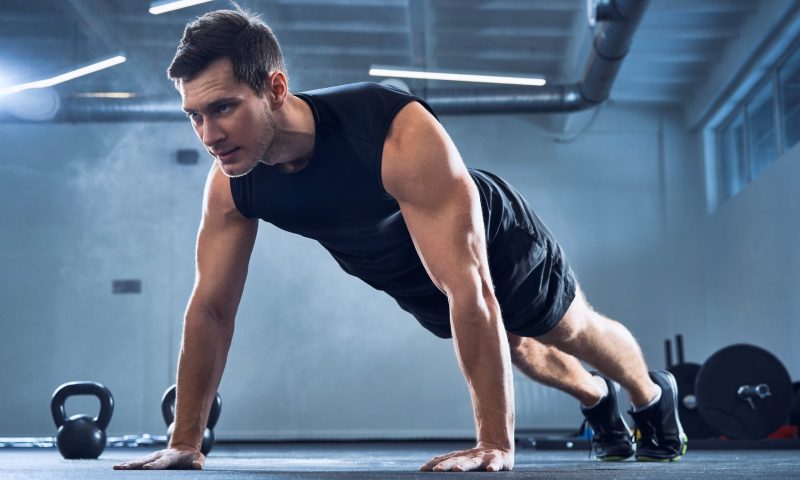
When some people refer to strength training, they’re specifically talking about resistance training involving the use of external resistance or weights like kettlebells or dumbbells to complete the exercise. However, you can also amass muscle strength by using your own body weight. Keep in mind that over time, you’ll hit a plateau because you won’t be able to increase the weight as you can when using external resistance.
Here are some of the most effective bodyweight strength training exercises to try, especially if you’re just starting out.
Hollow body hold

The hollow body hold is a superior bodyweight exercise that helps you work on core stability and a stronger foundation, which will prepare you for resistance training. This move improves your posture and fires up your transverse abdominis, rectus abdominis, obliques, quads, hip flexors, erector spinae, and more.
How to do the hollow body hold:
- Start lying on your back on a mat with your arms straight over your head and your legs extended.
- Engage your core and try to press your lower back into the floor.
- Squeeze your glutes and quads, point your toes, and lift your legs up off the ground.
- With your head in a neutral position, lift your shoulders up off the floor so your body resembles the shape of a banana. You should be holding your arms and legs extended up off the ground.
- At the top of this movement, only your lower back and hips should be in contact with the floor, and your legs and mid-back should be up off the floor.
- Hold this position with proper form.
- Carefully bring your legs and shoulders back to the floor to the starting position.
- Repeat until you complete the set.
Top tip: Keep your spine straight at the top of the movement.
Squat

The squat is a classic bodyweight exercise that has many benefits, including improving core strength, vertical jumping power, and bone density. Squatting targets your glutes, quads, hamstrings, adductors, hip flexors, and calves to refine your full-body power.
How to do a squat:
- Stand with your feet a little wider than shoulder-width apart.
- Point your toes forward and keep your chest up.
- Keep your core engaged and your spine neutral, and focus straight ahead.
- Push your hips backward and bend your knees to dip down into the squat as if you’re sitting on an invisible chair.
- Ideally, you want your hips to be parallel with your knees.
- At the lowest point of your squat, your elbows should touch the inside of your knees, and your knees should be bent at about 90 degrees with your thighs parallel to the floor.
- Press down with the heels of your feet and lift yourself back up to the starting position.
- Repeat until you complete the set.
Reverse lunge
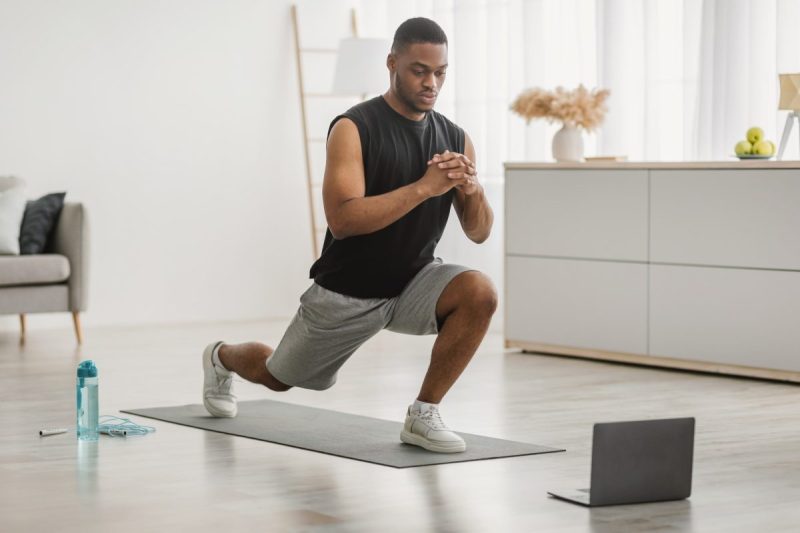
The reverse lunge is a compound exercise that works multiple muscle groups at the same time to level up your strength and endurance. You can use dumbbells for this exercise or simply use your own bodyweight, which will still enhance your muscular power. If you spend a lot of time sitting at a desk, reverse lunges are a great way to dynamically stretch your quads and hip flexors.
How to do a reverse lunge:
- Stand up with your feet about shoulders-distance apart.
- Engage your core and take a big step back with one leg.
- Lower your hips down until both legs are bent at a 90-degree angle.
- Hold the pose for a moment.
- Use both of your legs to push yourself back to the starting position at the same time.
- Repeat until you complete the set.
- Switch to the other leg.
Pushup

You don’t need any equipment to perform a pushup. You can try this classic strength-training exercise pretty much anywhere, and it’s suitable for beginners, advanced weightlifters, and those in between. Pushups work your shoulders, chest, core, and glutes.
How to do a pushup:
- Start on all fours with your hands about shoulder-width apart.
- Extend your legs back behind you so your spine and legs form a straight line and your knees and hips are in the plank position.
- Lower yourself down until your chest touches the floor and your elbows are at a 90-degree angle.
- Push yourself back up to straighten your arms.
- Repeat until you complete the set.
Glute bridge

You can add weights to the glute bridge to perform a weighted glute bridge and increase the difficulty. Either way, this exercise made our list because it’s a worthwhile strength training move that helps you gain core and spine stability, sculpt your derriere, and enhance your overall fitness level. Research reveals glute bridges activate and strengthen your erector spinae muscles that run along the length of your back.
How to do a glute bridge:
- Lay on your back on the floor with your feet flat on the floor and your knees bent. Your feet should be about hip-distance apart, and your arms should be by your sides, with your palms facing down.
- Engage your core, squeeze your glutes, push through your heels, and lift your hips up high to the ceiling.
- Don’t arch your back. Continue to lift up until your body forms a straight line from your head to your knees.
- Hold the position for a moment before slowly lowering your hips back down to the ground to the starting position.
- Repeat until you complete the set.
The best resistance strength training exercises
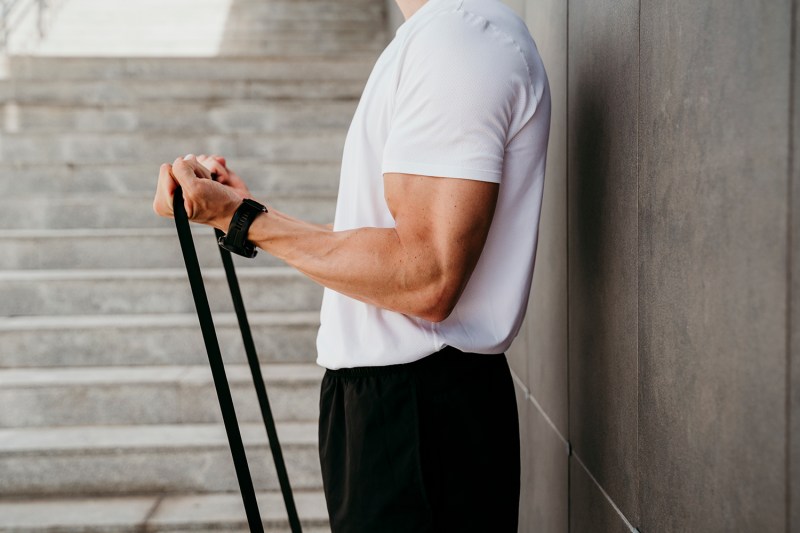
Up the ante and get ready to fire up those muscles with resistance training. You can perform these exercises with resistance bands, cable machines, weight machines, barbells, dumbbells, or kettlebells. Impressive research continues to show the benefits of resistance training, from improving body composition and immune health to getting ripped.
Dumbbell chopper
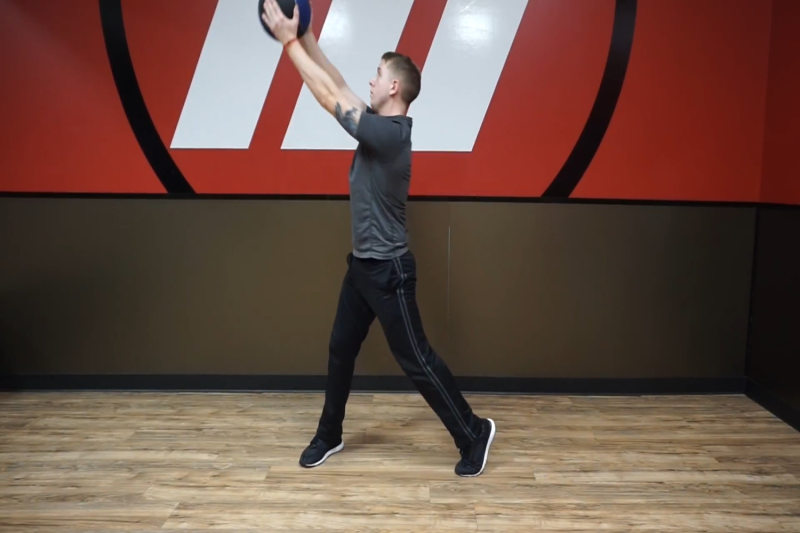
The dumbbell chopper, or the woodchopper, helps you practice rotational movements where you safely twist your spine. You can start practicing without the weight until you familiarize yourself with the rotational movement. The dumbbell chopper supercharges your core, obliques, legs, and glutes.
How to do the dumbbell chopper:
- Stand with your feet slightly wider than hip-distance apart.
- Engage your core and clasp your hands together, holding a dumbbell in both hands by your left leg.
- Raise your arms out and bring the dumbbell diagonally across the front of your body to your upper right. The goal is to rotate your torso while keeping your arms extended and bringing the weight from your left leg up above your head to the right as far as you can reach.
- Carefully rotate your torso and “chop” the weight back down to the starting position.
- Repeat until you complete the set.
- Switch to the other side.
Top tip: Rotate from your core and keep your body stable throughout the exercise.
Bicep curl
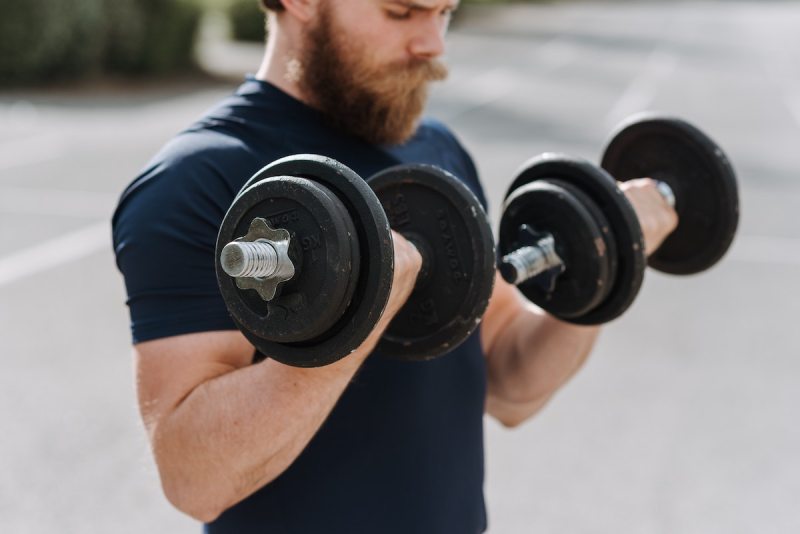
You can pump your biceps with the bicep curl and work both arms at the same time or one arm at a time. You can also perform the bicep curl in different ways, such as using a machine, dumbbells, or a barbell. As the name suggests, you’ll generate serious strength in your biceps with this weightlifter favorite.
How to perform a bicep curl:
- From a standing position, hold the dumbbells in your hands with an underhand grip.
- Bend your arms at the elbows and curl the dumbbells up as far as your elbows will go.
- Carefully lower the dumbbells back down to the starting position.
- Repeat until you complete the set.
Top tip: Keep your elbows close to your torso and maintain a neutral spine.
Goblet squat

Goblet squats help you jump higher, enhance your balance and strength, and perfect your squat form. You’ll hold a kettlebell or dumbbell in front of you at your center while squatting down. Holding the weight in front of you engages your quads a little more than other squat variations like the back squat. You’ll target your glutes, legs, core, and major lower body muscles.
How to do a goblet squat:
- Stand with your feet a little wider than hip-distance apart.
- Angle your toes slightly outward.
- Use both hands to grip the handles of the kettlebell as if you were a king cupping a goblet.
- With your elbows bent, position the kettlebell in the middle of your chest.
- Keep your core engaged and your spine neutral, and focus straight ahead.
- Bend your knees to dip down into the squat, keeping the kettlebell close to your body.
- Ideally, you want your hips to be parallel with your knees.
- At the lowest point of your goblet squat, your elbows should touch the inside of your knees.
- Press down with the heels of your feet and lift yourself back up to the starting position.
- Repeat until you complete the set.
Bent-over reverse fly

The bent-over reverse fly made our strength training list because it’s a killer workout for your rear deltoid muscles located on the back of your shoulders. The rear deltoids are often overlooked but they play a big role in helping you move your arms away from your midline. You can try this exercise with a cable machine, dumbbells, or a pec dec machine.
How to do the bent-over reverse fly with dumbbells:
- Stand upright and hold a dumbbell in each hand.
- Bend forward, hinging at your hips, so you’re leaning forward, but your torso isn’t completely parallel or horizontal with the floor.
- Extend your arms straight down so your palms are facing each other.
- Engage your core, squeeze your shoulder blades, and lift the weights up in a wide arc until your arms are in line with your back. (Think of this arcing motion like you’re an eagle spreading your wings).
- Pause for a moment before lowering the weights and bringing your arms back down to the starting position.
- Repeat until you complete the set.
Bent-over row
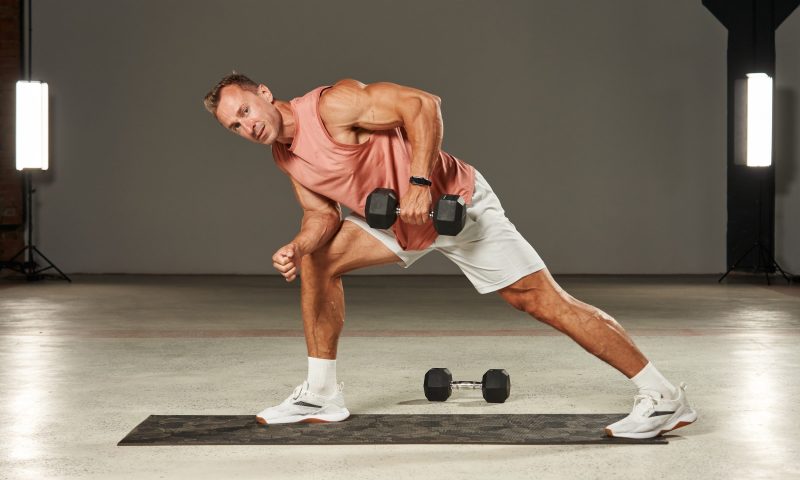
Engage your lats and biceps with the bent-over row — an awesome strength training rowing exercise. You’ll lower back pain and improve spinal stability and posture, overall strength, and grip strength. Bent-over rows work your upper back, rear deltoids at the back of your shoulders, lower back muscles, core, glutes, and biceps.
How to do the bent-over dumbbell row:
- Start in a lunge position with your left foot forward and your right foot back.
- Hold the dumbbell in your right hand.
- Lift or pull the weight up to your chest, making sure your elbow is bent at a 90-degree angle.
- Try to engage your core throughout this movement.
- Lower the weight back down.
- Repeat until you complete the set.
What are the benefits of strength training?

There are plenty of reasons to give strength training a try, such as:
- Developing stronger bones and lowering your risk of osteoporosis
- Managing your weight and boosting your metabolism
- Improving your quality of life
- Enhancing your general health and functional strength to make your everyday tasks that much more manageable
- Enhancing your mood with feel-good endorphins
- Sharpening your thinking and learning skills
Research highlights that muscle-strengthening physical activity can reduce the risks and symptoms of a range of chronic diseases, including arthritis and diabetes.
Strength training safety tips

Lower your risk of injury and maximize your outcome with these strength training safety tips:
- Don’t hold your breath, and make sure you’re breathing properly throughout the exercise.
- Warm up and cool down for about 5 or 10 minutes. Walking and stretching are excellent ways to warm up and cool down.
- Always focus on your form rather than lifting the heaviest weight or completing the most reps. Aim for controlled movements at a steady pace rather than trying to pick up your speed.
- Challenge your muscles by gradually increasing the weight or resistance. If you’re doing bodyweight exercises, you’ll reach a plateau at some point, so it might be a good time to consider resistance training and adding weights to your routine.
- Make sure you’re leaving 48 hours for your muscles to recover between strength training sessions.
- Lift the appropriate weight that challenges you but doesn’t compromise your form.
- Don’t overdo it and get carried away. Additional sets could lead to an overload injury.
- If you feel sharp pain, stop the exercise immediately.
- Remember to wear the right shoes that protect your feet from injury and stop you from slipping.
FAQs

Is 30 minutes of strength training enough?
Doing 30 minutes of strength training can definitely be enough time for you to build muscle, burn calories, and increase your strength as long as you perfect your form, effectively work all major muscle groups, and choose the right exercises and weights.
When will you see results?
You should notice improvements within two to six weeks of beginning strength training. The changes could be in your body composition, resting heart rate, or your general strength and athletic performance.
How many sets and reps should you do as a beginner?
How many sets and reps you should do depends on your goals, fitness level, and more. If you’re a beginner, shoot for 1 to 3 sets of 8 to 10 reps of each exercise. You can advance when you get stronger. In general, if you’re resistance training and ready to start building more strength, try to choose a weight you can lift for at least 8 to 10 reps per set with proper form. Give yourself 2 to 5 minutes of rest between sets.
How to introduce strength training into your workout schedule

Try to work all major muscle groups in your body two or three times every week. You could incorporate one full-body strength training workout two or three times every week or break your strength training up into lower body and upper body days. Make sure to hit your upper body at least twice every week and your lower body at least twice a week to maximize gains.
People try strength training to develop a more muscular physique, enhance muscle definition, feel stronger and healthier, and reap the many benefits. Soon you’ll be lifting heavier weights and trying more advanced variations or new exercises. It might seem difficult for beginners at first, but once you conquer each move and feel yourself getting stronger, you’ll be pleased you stuck with it.




